Verification of the Structural Performance of Textile Reinforced Reactive Powder Concrete Sandwich Facade Elements
Abstract
1. Introduction
2. Sandwich Façade Element Concept
2.1. Sandwich Element Details
2.2. Anchorage System
3. Materials
3.1. Textile Reinforced Reactive Powder Concrete (TRRPC)
3.2. Foam Concrete (FC)
3.3. Glass Fibre Reinforced Polymer (GFRP) Connectors
4. Methods
4.1. Experimental Methods
4.1.1. Anchorage Testing
4.1.2. Wind Load Testing
4.2. Numerical Modelling
4.2.1. General Parameters
4.2.2. Wind Load Test Model
4.2.3. Full-Size Sandwich Element Model
5. Experimental Results of Element Tests
5.1. Anchor Shear Load Capacities
5.2. Wind Load Test Results
6. Numerical Results
6.1. Validation of Wind Load Test Model
6.2. Performance of Full-Size Sandwich Element
6.3. Performance of Full-Size Sandwich Element with Openings
7. Discussion
Author Contributions
Funding
Acknowledgments
Conflicts of Interest
References
- Stenberg, E. Structural Systems of the Million Program Era; KTH School of Architecture: Stockholm, Sweden, 2013. [Google Scholar]
- EN 206-1. Concrete-Specification, Performance, Production and Conformity; European Standard: Brussels, Belgium, 2013. [Google Scholar]
- Engberts, E. Large-size facade Elements of textile reinforced concrete. In ICTRC’2006-1st International RILEM Conference on Textile Reinforced Concrete; Hegger, J., Brameshuber, W., Will, N., Eds.; RILEM Publications SARL: Paris, France, 2006. [Google Scholar]
- Hegger, J.; Horstmann, M.; Scholzen, A. Sandwich Panels with Thin-Walled Textile-Reinforced Concrete Facings. Spec. Publ. 2008, 251, 109–124. [Google Scholar]
- Colombo, I.G.; Colombo, M.; di Prisco, M. Bending behaviour of Textile Reinforced Concrete sandwich beams. Constr. Build. Mater. 2015, 95, 675–685. [Google Scholar] [CrossRef]
- Shams, A.; Stark, A.; Hoogen, F.; Hegger, J.; Schneider, H. Innovative sandwich structures made of high performance concrete and foamed polyurethane. Compos. Struct. 2015, 121, 271–279. [Google Scholar] [CrossRef]
- Miccoli, L.; Fontana, P.; Silva, N.; Klinge, A.; Cederqvist, C.; Kreft, O.; Sjöström, C. Composite UHPC-AAC/CLC facade elements with modified interior plaster for new buildings and refurbishment. J. Facade Des. Eng. 2015, 3, 91–102. [Google Scholar]
- Ghoneim, G.; El-Hacha, R.; Carson, G.; Zakariasen, D. Precast Ultra High Perfromance Fibre Reinforced Concrete Replaces Stone And Granite On Building Façade. In Proceedings of the 3rd International Fib Congress incorporating the PCI Annual Convention and Bridge Conference, Washington, DC, USA, 29 May–2 June 2010; pp. 1–15. [Google Scholar]
- Rebentrost, M.; Wight, G.; Fehling, E. Experience and applications of ultra-high performance concrete in Asia. In Proceedings of the 2nd International Symposium on Ultra High Performance Concrete, Kassel, Germany, 5–7 March 2008; pp. 19–30. [Google Scholar]
- Papanicolaou, C. Applications of textile-reinforced concrete in the precast industry. In Textile Fibre Composites in Civil Engineering; Thanasis, T., Ed.; Elsevier: Amsterdam, The Netherlands, 2016; pp. 227–244. [Google Scholar]
- Mueller, U.; Williams Portal, N.; Chozas, V.; Flansbjer, M.; Larazza, I.; da Silva, N.; Malaga, K. Reactive powder concrete for facade elements—A sustainable approach. J. Facade Des. Eng. 2016, 4, 53–66. [Google Scholar] [CrossRef]
- Hegger, J.; Kulas, C.; Horstmann, M. Spatial textile reinforcement structures for ventilated and sandwich façade elements. Adv. Struct. Eng. 2012, 15, 665–675. [Google Scholar] [CrossRef]
- Salmon, D.C.; Einea, A.; Tadros, M.K.; Culp, T.D. Full scale testing of precast concrete sandwich panels. ACI Struct. J. 1997, 94, 239–247. [Google Scholar]
- Lameiras, R.; Barros, J.; Valente, I.B.; Azenha, M. Development of sandwich panels combining fibre reinforced concrete layers and fibre reinforced polymer connectors. Part I: Conception and pull-out tests. Compos. Struct. 2013, 105, 446–459. [Google Scholar] [CrossRef]
- Lameiras, R.; Barros, J.; Azenha, M.; Valente, I.B. Development of sandwich panels combining fibre reinforced concrete layers and fibre reinforced polymer connectors. Part II: Evaluation of mechanical behaviour. Compos. Struct. 2013, 105, 460–470. [Google Scholar] [CrossRef]
- Assaad, J.; Chakar, E.; Zéhil, G.-P. Testing and modeling the behavior of sandwich lightweight panels against wind and seismic loads. Eng. Struct. 2018, 175, 457–466. [Google Scholar] [CrossRef]
- Cuypers, H.; Wastiels, J. Analysis and verification of the performance of sandwich panels with textile reinforced concrete faces. J. Sandw. Struct. Mater. 2011, 13, 589–603. [Google Scholar] [CrossRef]
- De Munck, M.; Vervloet, J.; Kadi, M.E.; Verbruggen, S.; Wastiels, J.; Remy, O.; Tysmans, T. Modelling and experimental verification of flexural behaviour of textile reinforced cementitious composite sandwich renovation panels. In Proceedings of the 12th Fib International PhD Symposium in Civil Engineering, Prague, Czech Republic, 29–31 August 2018; pp. 179–186. [Google Scholar]
- Djamai, Z.I.; Bahrar, M.; Salvatore, F.; Si Larbi, A.; El Mankibi, M. Textile reinforced concrete multiscale mechanical modelling: Application to TRC sandwich panels. Finite Elem. Anal. Des. 2017, 135, 22–35. [Google Scholar] [CrossRef]
- Mueller, U.; Williams Portal, N.; Flansbjer, M.; Malaga, K. Textile Reinforced Reactive Powder Concrete and its Application for Facades. In Proceedings of the Eleventh High Performance Concrete (11th HPC) and the Second Concrete Innovation Conference (2nd CIC), Tromsø, Norway, 6–8 March 2017. [Google Scholar]
- Williams Portal, N.; Flansbjer, M.; Mueller, U. Experimental Study on Anchorage in Textile Reinforced Reactive Powder Concrete. Nord. Concr. Res. 2017, 2, 33. [Google Scholar]
- Flansbjer, M.; Williams Portal, N.; Vennetti, D.; Mueller, U. Composite Behaviour of Textile Reinforced Reactive Powder Concrete Sandwich Façade Elements. Int. J. Concr. Struct. Mater. 2018, 12, 71. [Google Scholar] [CrossRef]
- Flansbjer, M.; Honfi, D.; Mueller, U.; Wlasak, L.; Williams Portal, N.; Edgar, J.-O.; Larraza, I. Structural behaviour of RPC sandwich facade elements with GFRP connectors. In Proceedings of the 7th International Congress on Architectural Envelopes, San Sebastian-Donostia, Spain, 27–29 May 2015. [Google Scholar]
- Flansbjer, M.; Honfi, D.; Vennetti, D.; Mueller, U.; Williams Portal, N.; Wlasak, L. Structural performance of GFRP connectors in composite sandwich façade elements. J. Facade Des. Eng. 2016, 4, 35–52. [Google Scholar] [CrossRef]
- Silva, N.; Mueller, U.; Malaga, K.; Hallingberg, P.; Cederqvist, C. Foam concrete-aerogel composite for thermal insulation in lightweight sandwich facade elements. In Proceedings of the 27th Biennial National Conference of the Concrete Institute of Australia in Conjunction with the 69th RILEM Week, Melbourne, Australia, 30 August–2 September 2018. [Google Scholar]
- Williams Portal, N.; Flansbjer, M.; Johanesson, P.; Malaga, K.; Lundgren, K. Tensile behaviour of textile reinforcement under accelerated ageing conditions. J. Build. Eng. 2015, 5, 57–66. [Google Scholar] [CrossRef]
- RILEM TC 232-TDT. Recommendation of RILEM TC 232-TDT: Test Methods and Design of Textile Reinforced Concrete-Uniaxial Tensile Test: Test Method to Determine the Load Bearing Behavior of Tensile Specimens Made of Textile Reinforced Concrete; RILEM TC 232-TDT: Paris, France, 2016; pp. 4923–4927. [Google Scholar]
- Van Deijk, S. Foam concrete. Concrete 1991, 25, 49–54. [Google Scholar]
- ISO 10406-1. Fibre-Reinforced Polymer (FRP) Reinforcement of Concrete-Test Methods. Part 1: FRP Bars and Grids; International Organization for Standardization: Geneva, Switzerland, 2008. [Google Scholar]
- Dassault Systèmes Abaqus/CAE User’s Guide. ABAQUS Version 6.14; Groupe Dassault: Paris, France, 2014. [Google Scholar]
- EN 1990. Eurocode-Basis of Structural Design European Standard; EN 1990: Brussels, Belgium, 2005. [Google Scholar]
- EN 1991-1-4. Eurocode 1: Actions on Structures-Part 1-4: General Actions-Wind Actions European Standard; EN 1991-1-4: Brussels, Belgium, 2005. [Google Scholar]
- EN 1992-1-1. Eurocode 2: Design of Concrete Structures-Part 1-1: General Rules and Rules for Buildings. European Standard; EN 1992-1-1: Brussels, Belgium, 2014. [Google Scholar]
- Fib. Fib Bulletin No. 40-FRP Reinforcement in RC Structures. 2007. Available online: https://www.fib-international.org/publications/fib-bulletins/frp-reinforcement-in-rc-structures-115-detail.html (accessed on 3 December 2018).
- ACI Commitee 533. 533R-11 Guide for Precast Concrete Wall Panels. 2012. Available online: https://www.concrete.org/publications/internationalconcreteabstractsportal/m/details/id/51683674 (accessed on 3 December 2018).
- SIS-CEN/TS-1992-4-1. Design of Fastenings for Use in Concrete-Part 4-1: General European Standard; SIS-CEN/TS-1992-4-1: Brussels, Belgium, 2010. [Google Scholar]



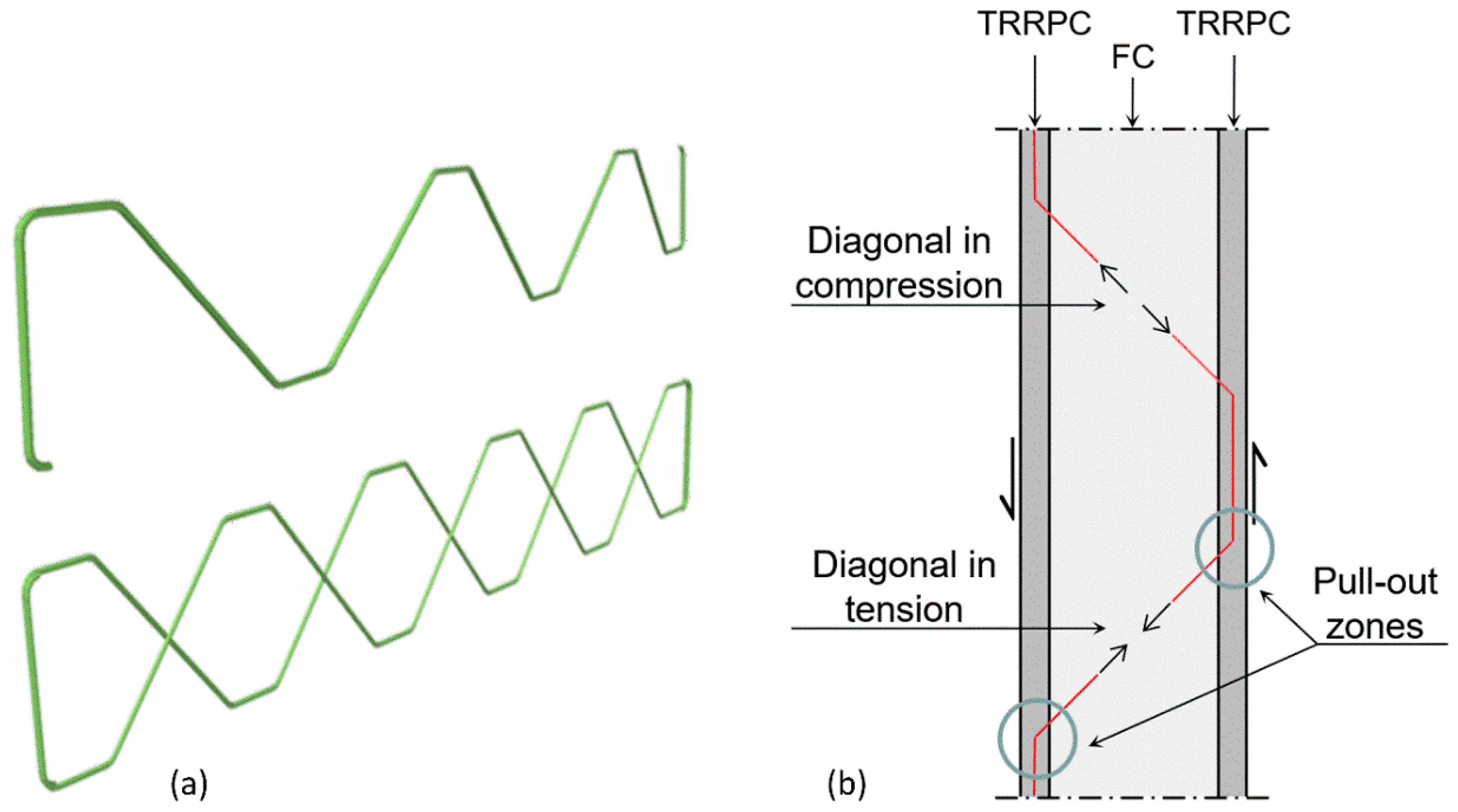
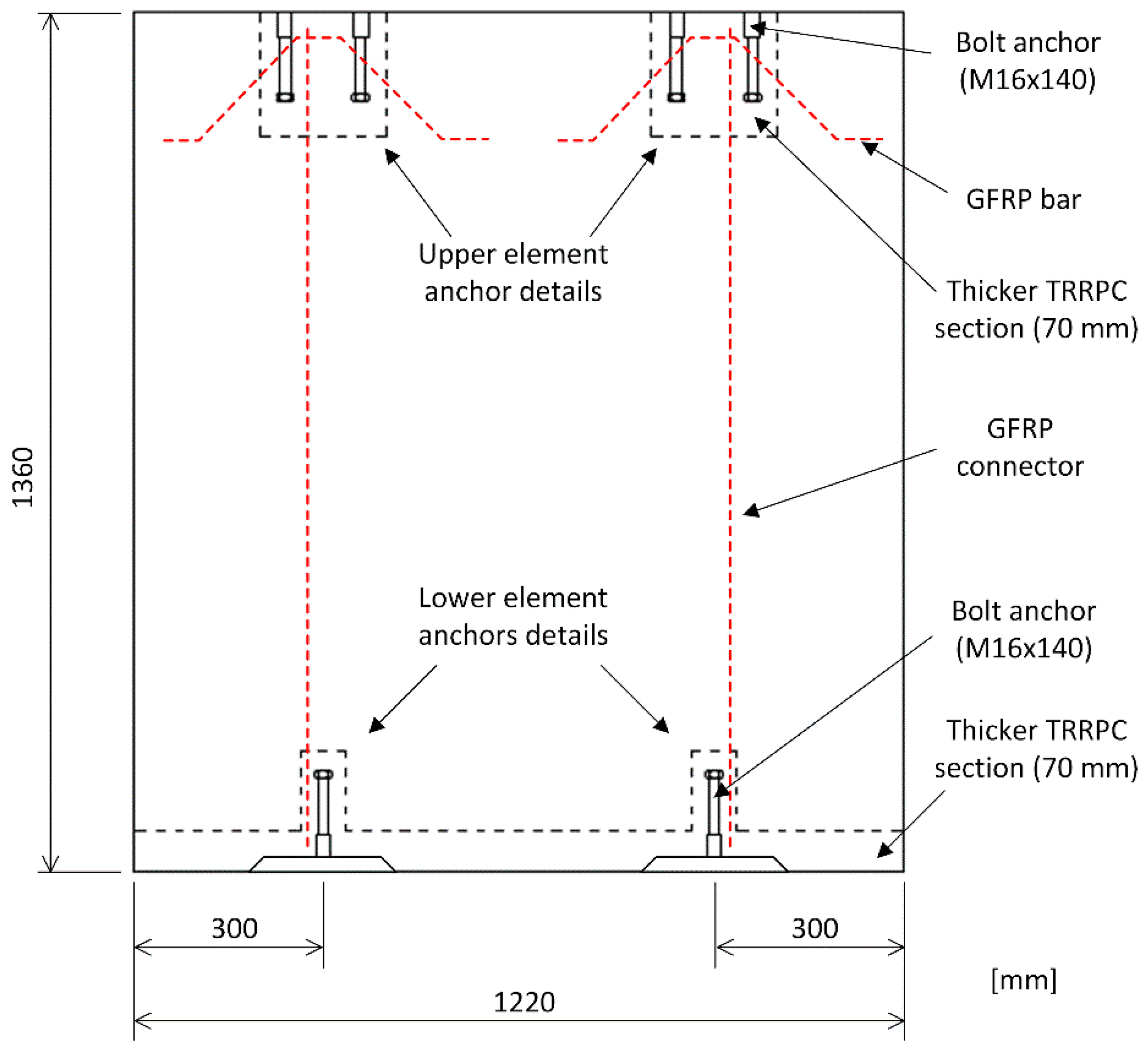

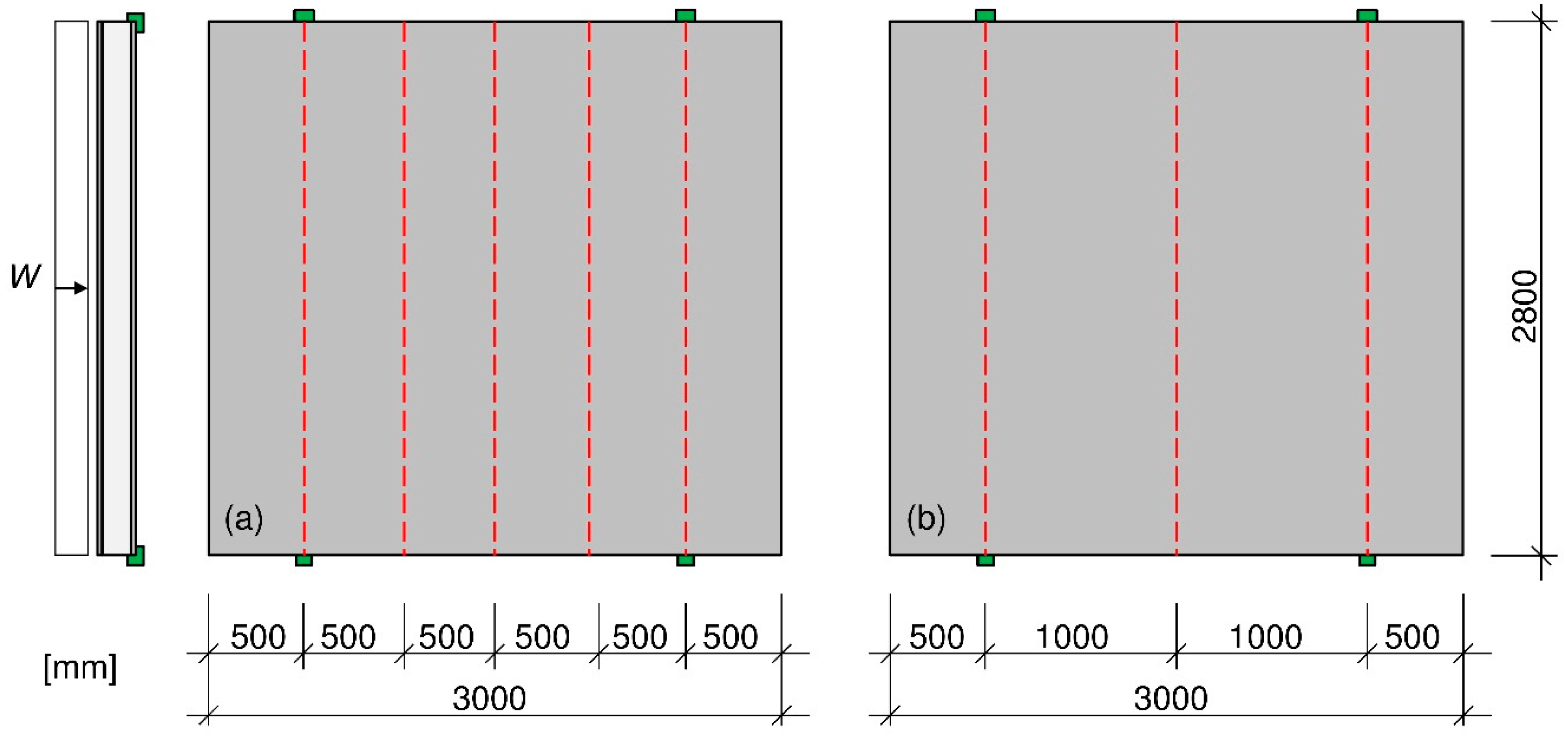
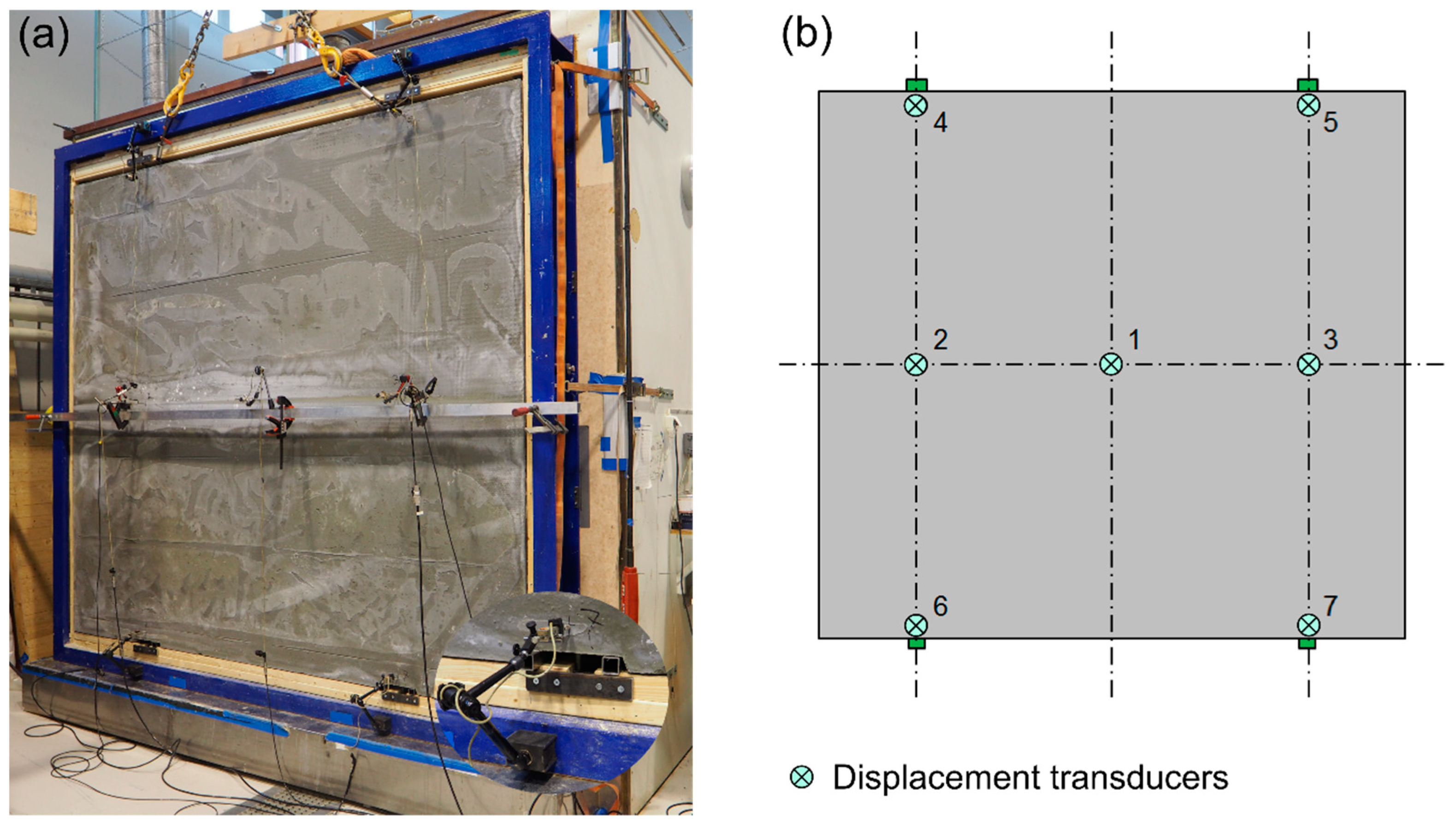
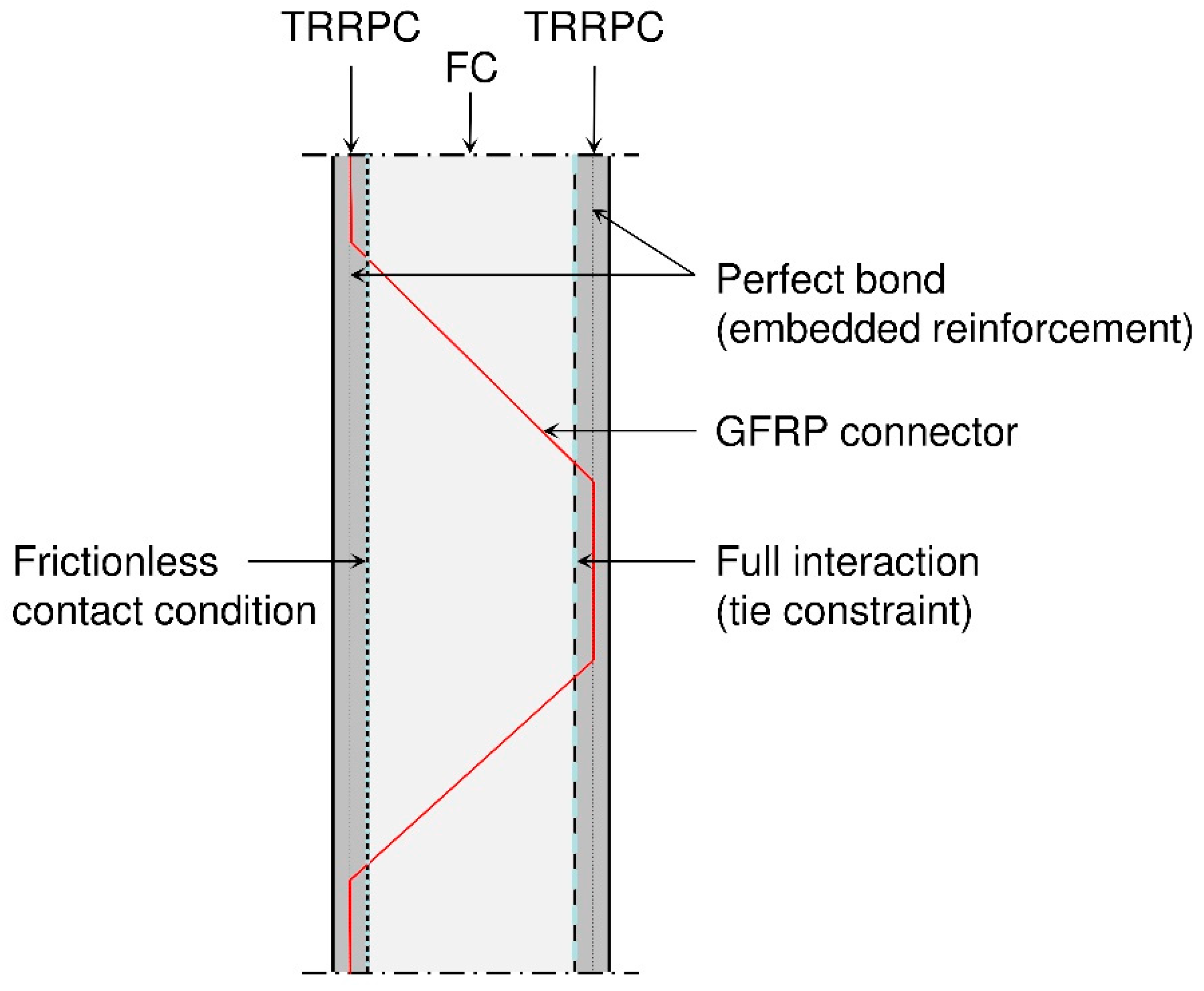
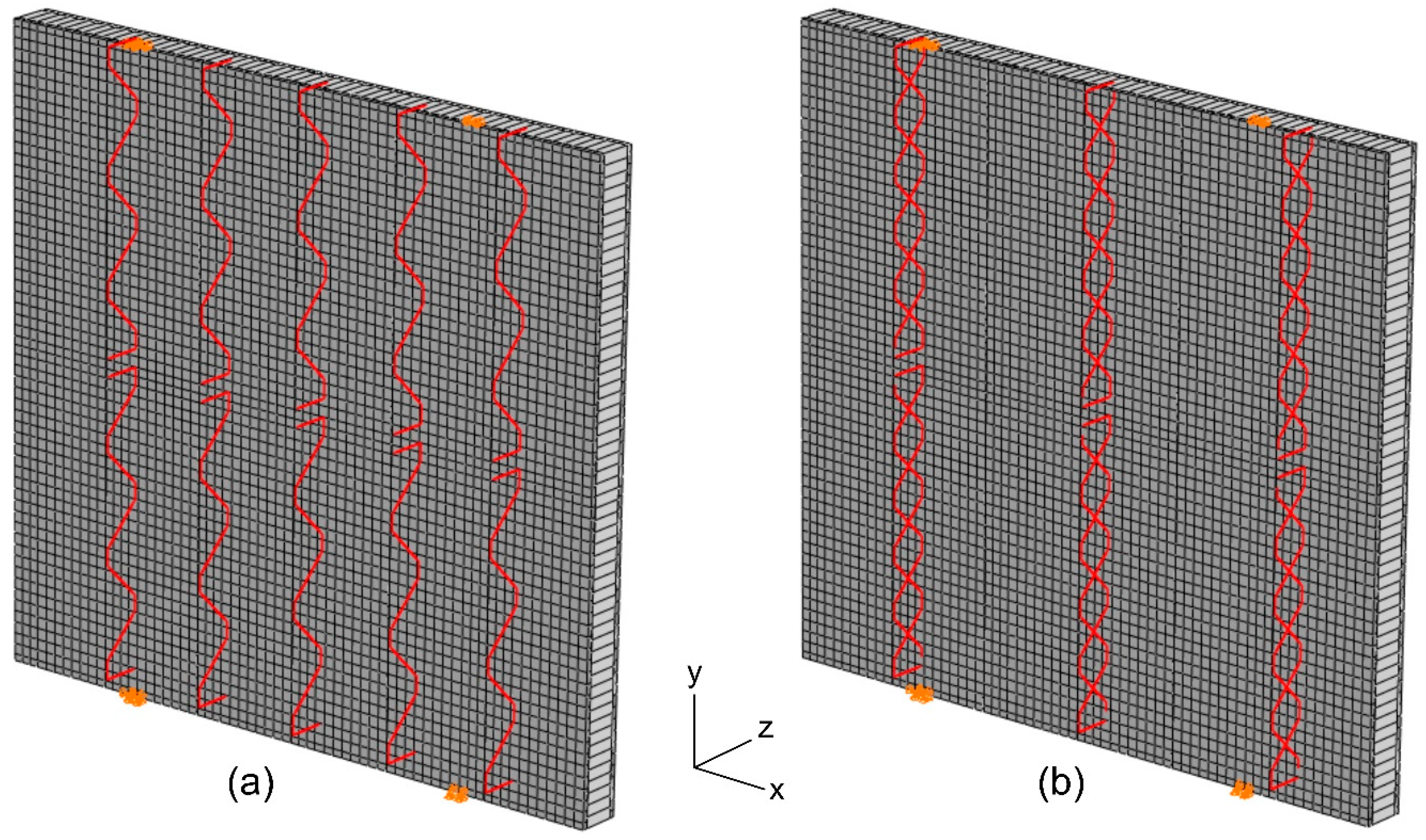
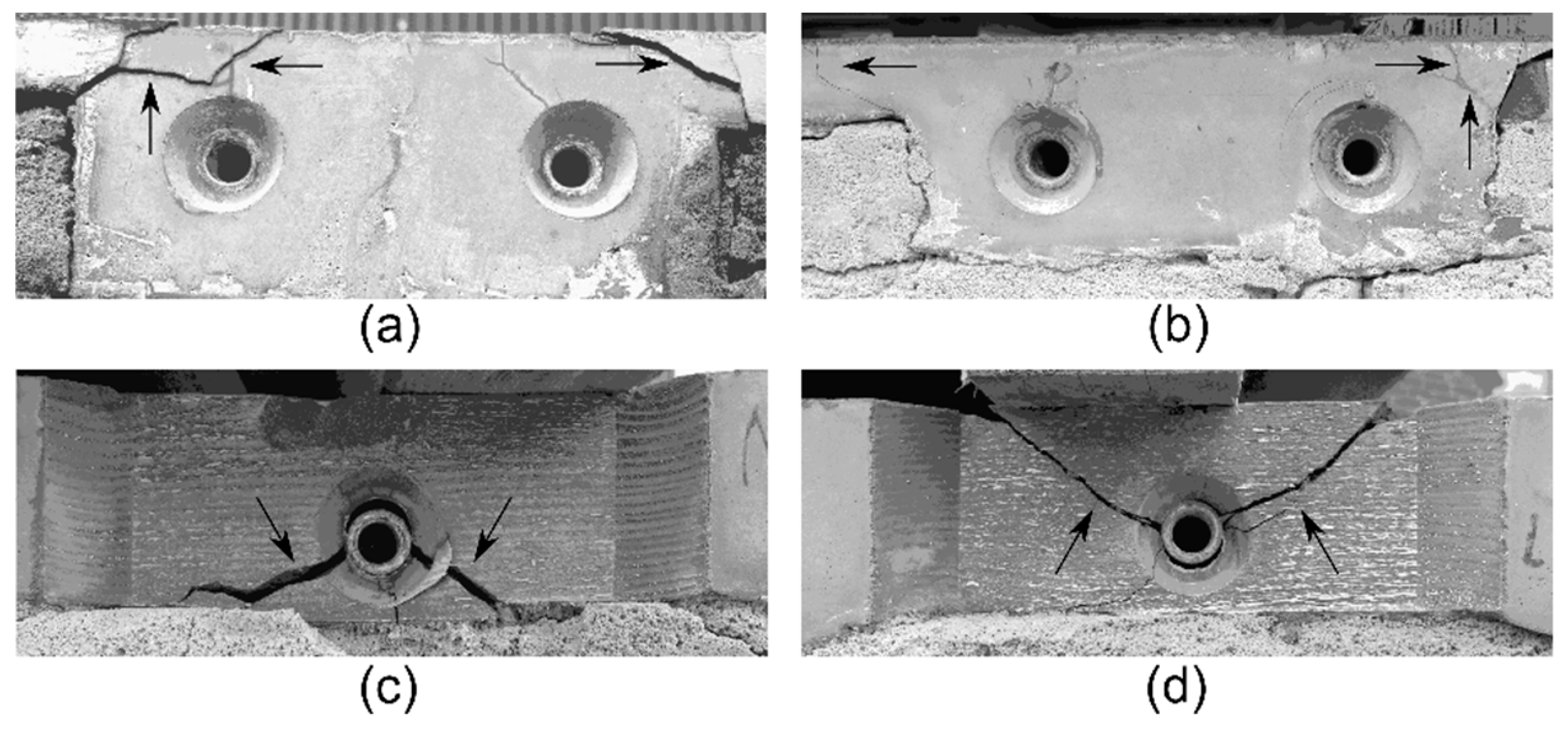
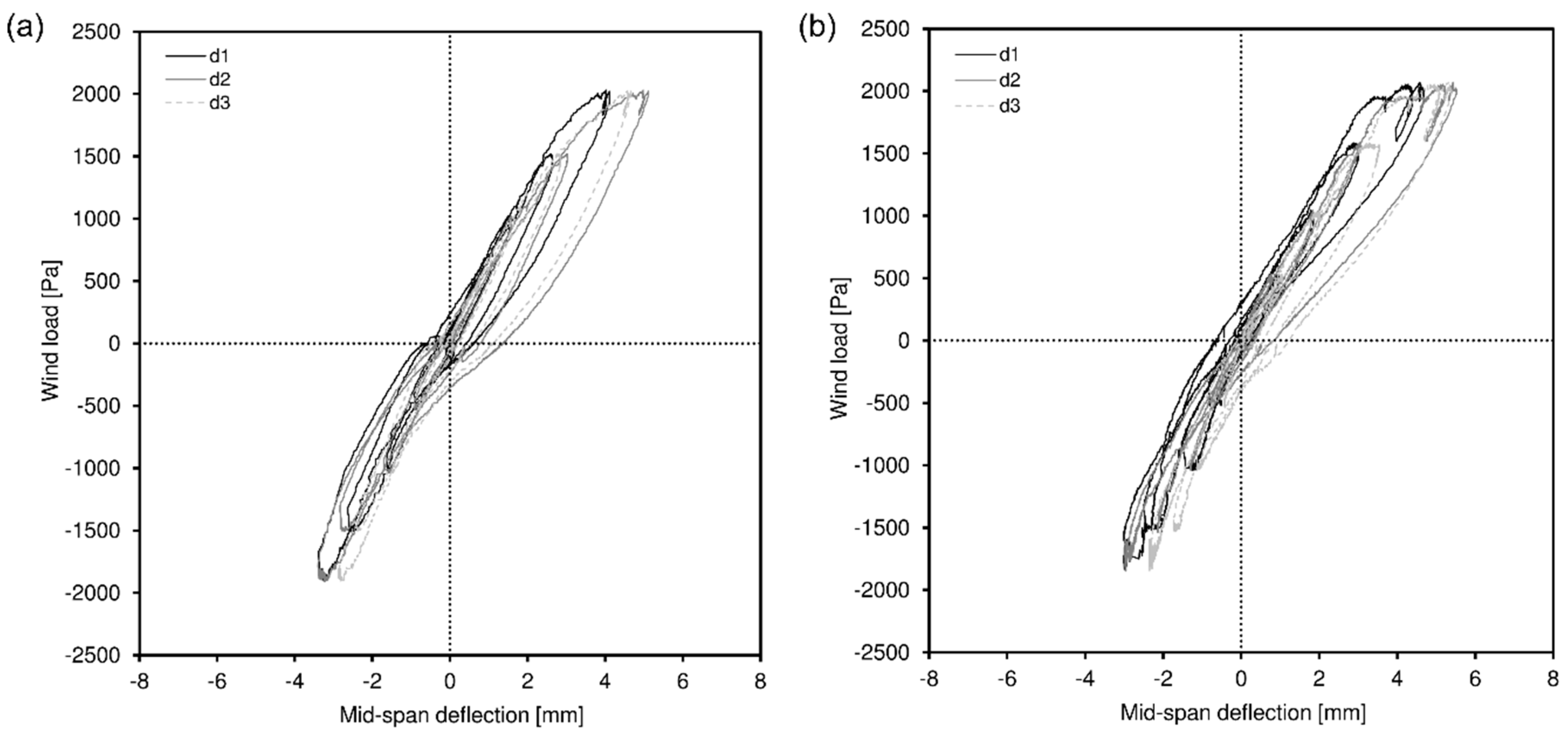
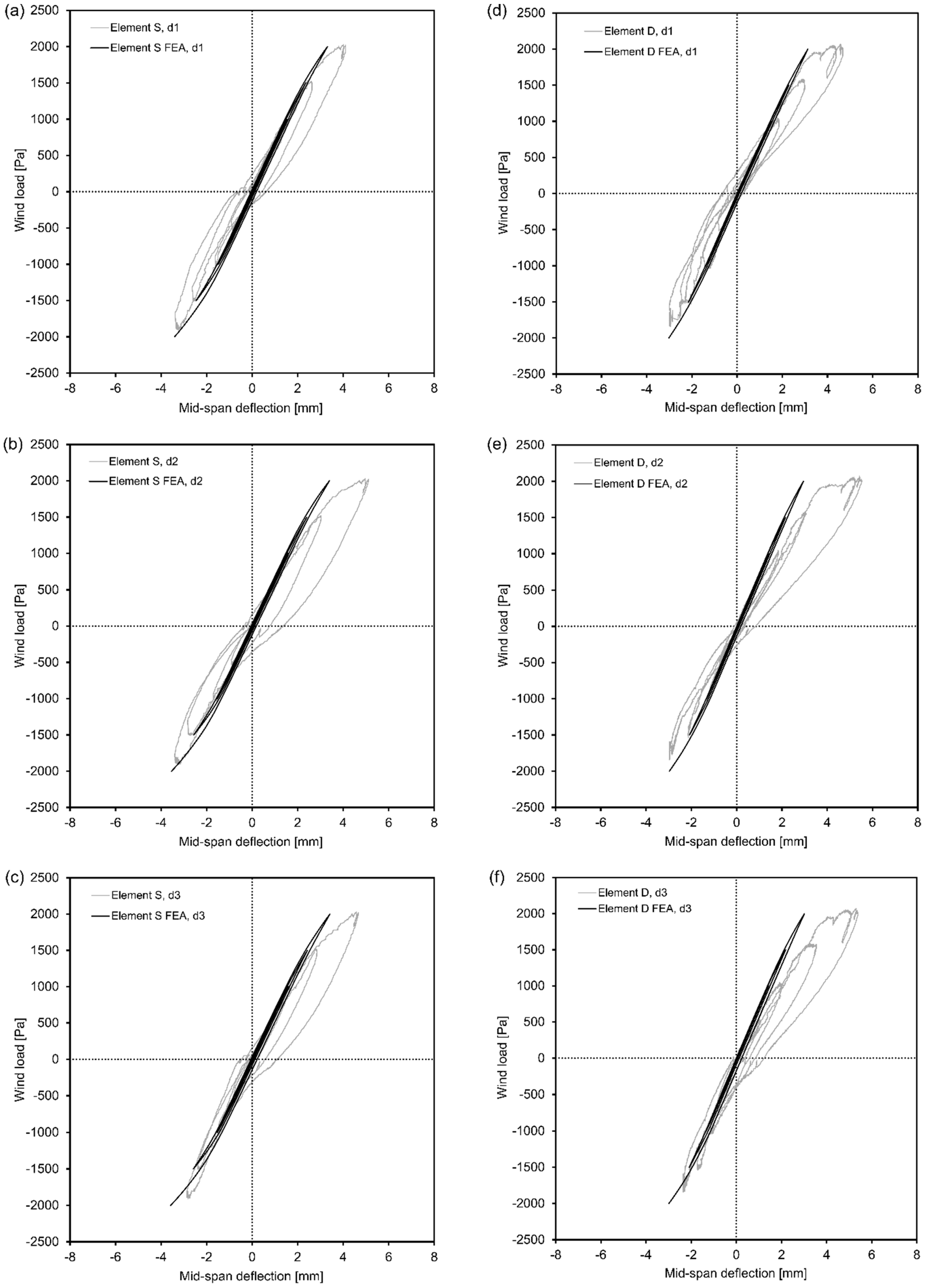
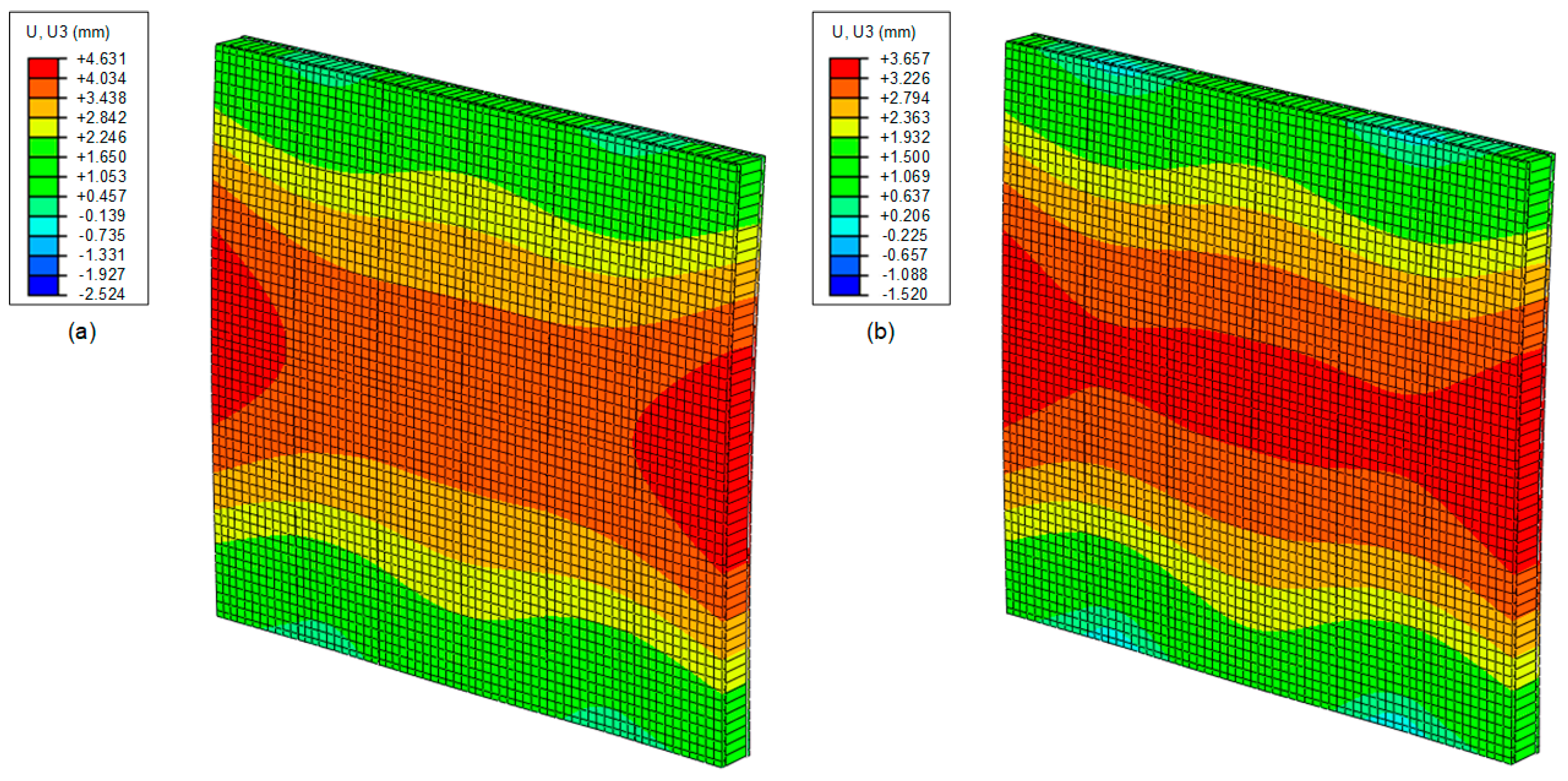
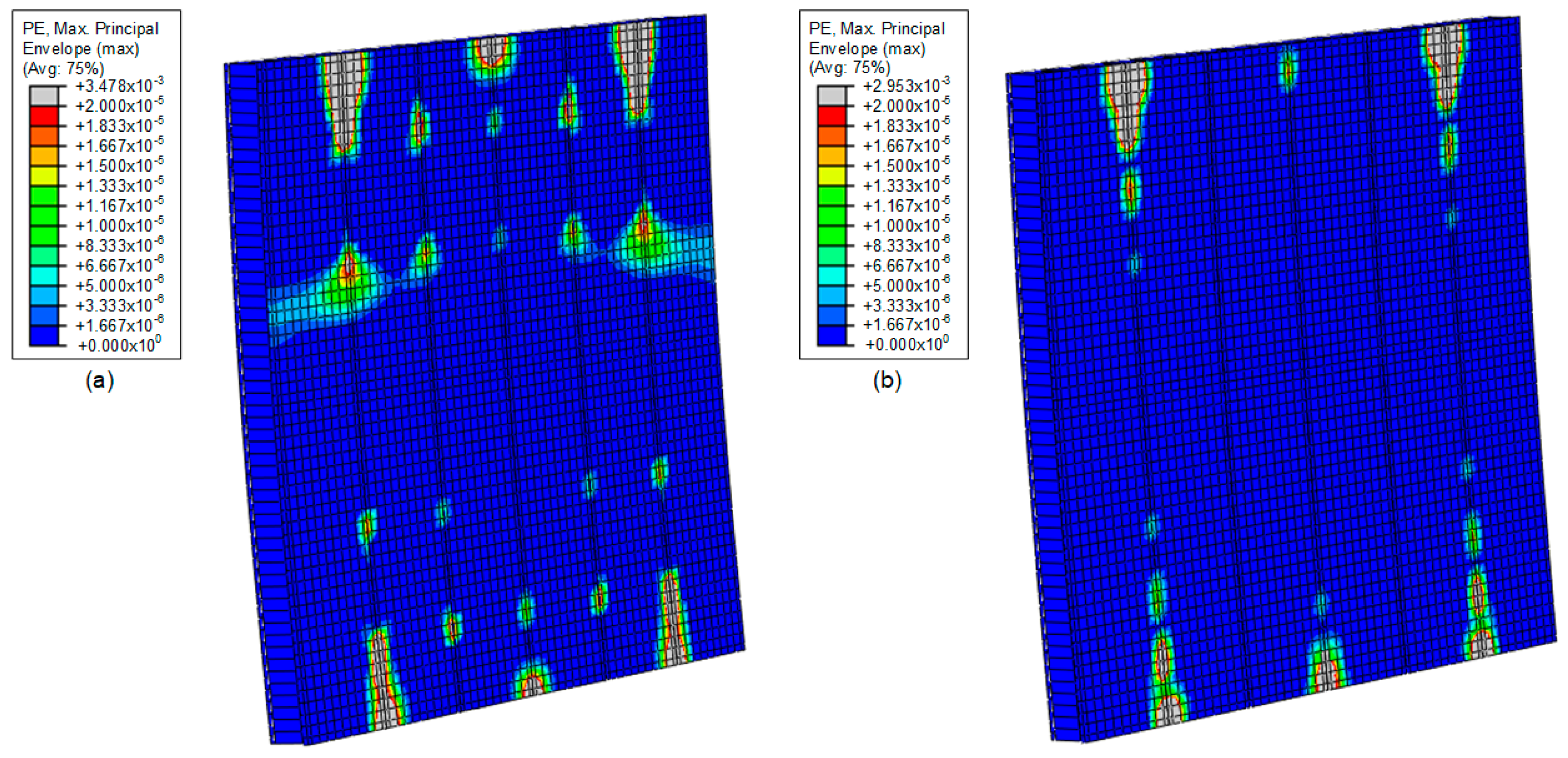
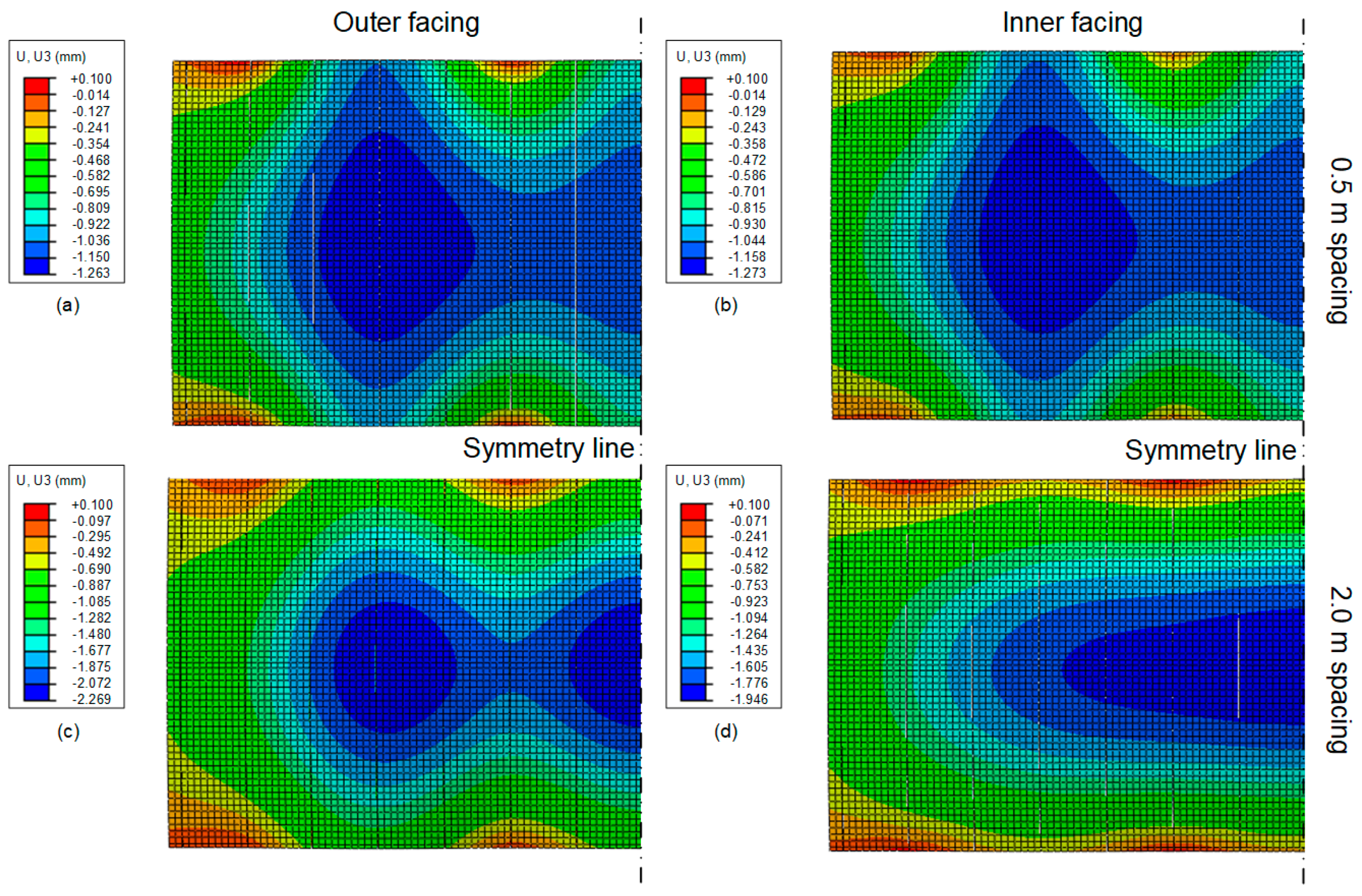
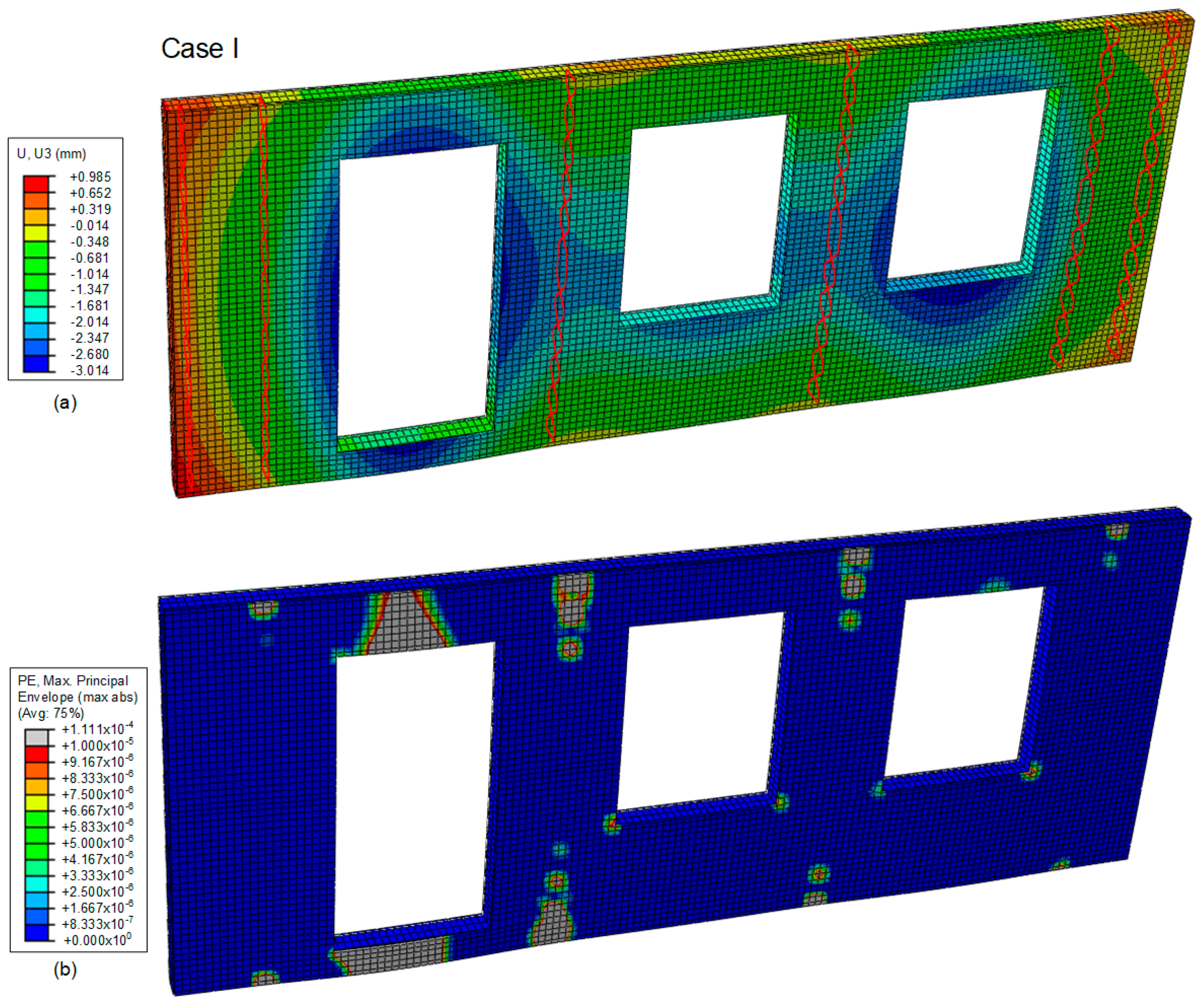
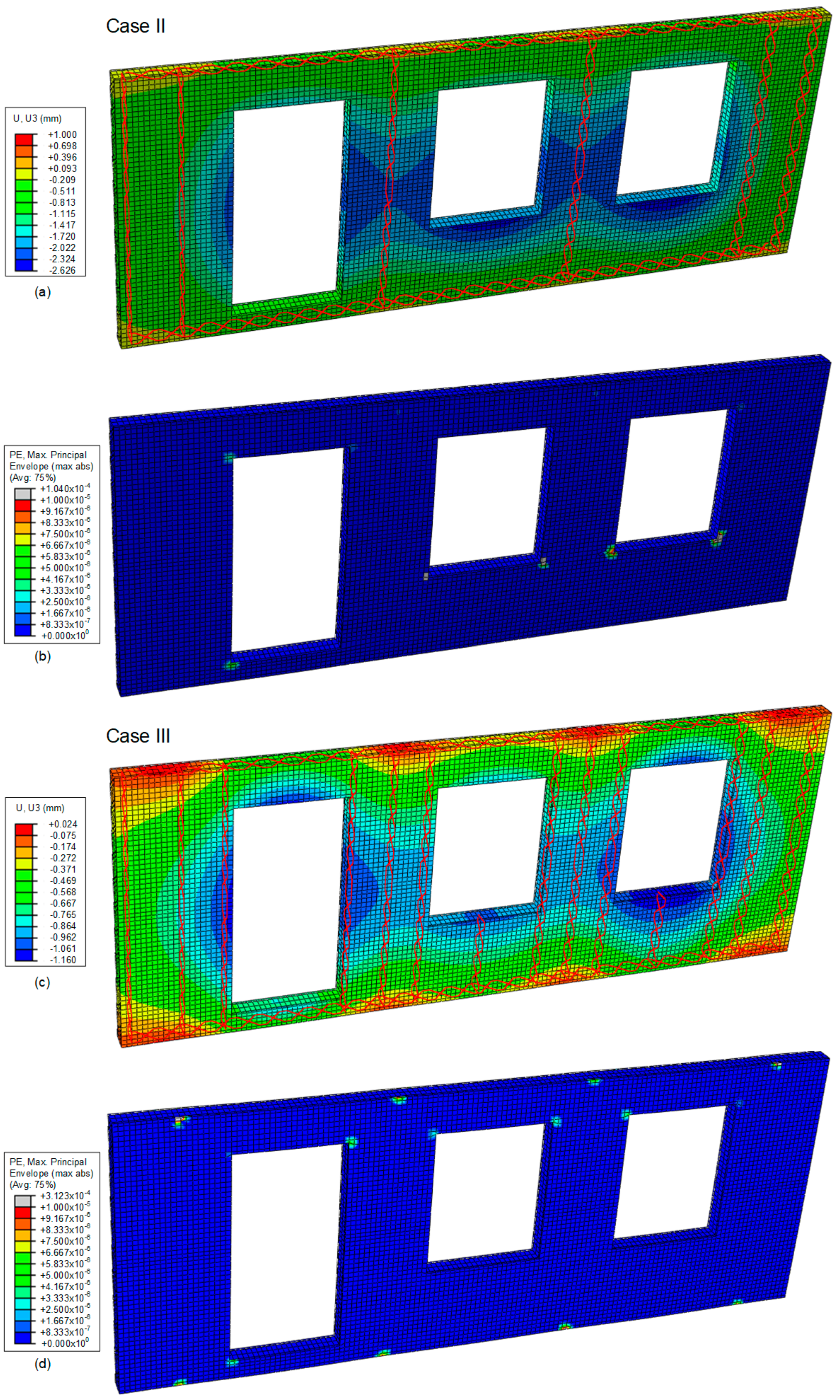
| Property | Average Values | Test Description |
|---|---|---|
| Compressive strength [MPa] | 147.2 (2.3) | Compression tests |
| E-modulus [GPa] | 49.7 (1.7) | |
| Ultimate strain [‰] | 3.9 (0.2) | |
| Poisson’s ratio [–] | 0.22 (0.02) | |
| Tensile strength [MPa] | 5.1 (0.5) | Uniaxial tensile tests |
| Property | Average Values | Test Description |
|---|---|---|
| Ultimate tensile capacity [MPa] | 1012 (35) | Tensile test ISO 10406-1 [29] |
| Ultimate strain [%] | 2.5 (0.1) | |
| Young’s modulus [GPa] | 40.3 (0.8) | |
| Critical buckling load [kN] | 1.7 (0.1) (1) | Compression tests |
| Pull-out capacity [kN] | 6.5 (0.5) | Connector pull-out test |
| Load Case | SLS | ULS | ||||
|---|---|---|---|---|---|---|
| Wext [Pa] | Wint [Pa] | WSLS [Pa] | Wext [Pa] | Wint [Pa] | WULS [Pa] | |
| LC1 | 514 | 192 | 706 | 771 | 288 | 1059 |
| LC2 | −771 | −128 | −899 | −1157 | −192 | −1349 |
| LC3 | −771 | 192 | −579 | −1157 | 288 | −869 |
| Test Case | A | B | C | D | ||||
|---|---|---|---|---|---|---|---|---|
| Anchor position | upper | upper | lower | lower | ||||
| Shear load direction | positive | negative | positive | negative | ||||
| Number of tests | 4 | 4 | 6 | 6 | ||||
| Average value | HRup,m [kN] | 12.4 | HRun,m [kN] | 12.1 | HRlp,m [kN] | 8.7 | HRln,m [kN] | 9.9 |
| Standard deviation | σ [kN] | 1.0 | σ [kN] | 2.5 | σ [kN] | 1.0 | σ [kN] | 1.5 |
| Coefficient of variation | Vx [–] | 0.08 | Vx [–] | 0.21 | Vx [–] | 0.12 | Vx [–] | 0.15 |
| Characteristic fractile factor | kn [–] | 1.83 | kn [–] | 1.83 | kn [–] | 1.77 | kn [–] | 1.77 |
| Characteristic value | HRup,k [kN] | 10.5 | HRun,k [kN] | 7.5 | HRlp,k [kN] | 6.9 | HRln,k [kN] | 7.3 |
| Design value | HRup,d [kN] | 7.0 | HRun,d [kN] | 5.0 | HRlp,d [kN] | 4.6 | HRln,d [kN] | 4.8 |
| Connector Spacing [m] | Load Case | SLS | ULS | Failure | |||||
|---|---|---|---|---|---|---|---|---|---|
| Umax [mm] | Cracks | HEl,d [kN] | HEu,d [kN] | FEpo,d [kN] | Wmax [Pa] | Wmax/WULS [–] | Failure Mode | ||
| 0.5 | LC1 | 0.8 | Minor | −3.5 | −2.6 | 1.0 | 1420 | 1.3 | Lower anchor |
| LC2 | −1.1 | Minor | 3.5 | 4.3 | 1.8 | −1590 | 1.2 | Upper anchor | |
| LC3 | −0.8 | Minor | 2.1 | 2.9 | 1.4 | −1590 | 1.8 | Upper anchor | |
| 1.0 | LC1 | 1.1 | Minor | −3.5 | −2.7 | 1.5 | 1460 | 1.4 | Lower anchor |
| LC2 | −1.6 | Minor | 3.5 | 4.3 | 2.7 | −1610 | 1.2 | Upper anchor | |
| LC3 | −1.0 | Minor | 2.1 | 2.9 | 1.9 | −1620 | 1.9 | Upper anchor | |
| 2.0 | LC1 | 1.5 | Minor | −3.4 | −2.7 | 1.9 | 1470 | 1.4 | Lower anchor |
| LC2 | −2.0 | Minor | 3.5 | 4.2 | 3.3 | −1550 | 1.1 | Conn. pull-out | |
| LC3 | −1.2 | Minor | 2.1 | 2.8 | 2.4 | −1450 | 1.7 | Conn. pull-out | |
| Case | Load Case | SLS | ULS | Failure | |||||
|---|---|---|---|---|---|---|---|---|---|
| umax [mm] | Cracks | HEI,d [kN] | HEu,d [kN] | FEDO,d [kN] | Wmax [Pa] | Wmax/WULS [−] | Failure Mode | ||
| I | LC2 | −3.0 | Major | 3.8 | 4.3 | 3.7 | −1350 | 1.0 | Con. Pull-out |
| II | LC2 | −2.6 | Minor | 3.7 | 4.1 | 3.3 | −1530 | 1.1 | Con. Pull-out |
| III | LC2 | −1.2 | Minor | 3.6 | 4.1 | 1.6 | −1680 | 1.2 | Upper anchor |
© 2019 by the authors. Licensee MDPI, Basel, Switzerland. This article is an open access article distributed under the terms and conditions of the Creative Commons Attribution (CC BY) license (http://creativecommons.org/licenses/by/4.0/).
Share and Cite
Flansbjer, M.; Williams Portal, N.; Vennetti, D. Verification of the Structural Performance of Textile Reinforced Reactive Powder Concrete Sandwich Facade Elements. Appl. Sci. 2019, 9, 2456. https://doi.org/10.3390/app9122456
Flansbjer M, Williams Portal N, Vennetti D. Verification of the Structural Performance of Textile Reinforced Reactive Powder Concrete Sandwich Facade Elements. Applied Sciences. 2019; 9(12):2456. https://doi.org/10.3390/app9122456
Chicago/Turabian StyleFlansbjer, Mathias, Natalie Williams Portal, and Daniel Vennetti. 2019. "Verification of the Structural Performance of Textile Reinforced Reactive Powder Concrete Sandwich Facade Elements" Applied Sciences 9, no. 12: 2456. https://doi.org/10.3390/app9122456
APA StyleFlansbjer, M., Williams Portal, N., & Vennetti, D. (2019). Verification of the Structural Performance of Textile Reinforced Reactive Powder Concrete Sandwich Facade Elements. Applied Sciences, 9(12), 2456. https://doi.org/10.3390/app9122456





